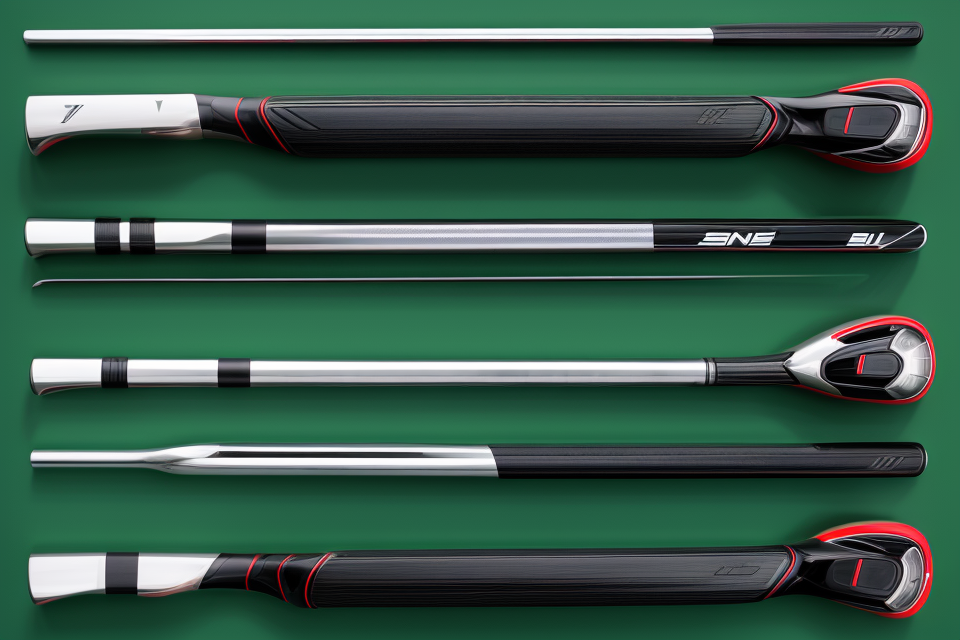
Golf is a sport that requires precision and accuracy, and the choice of the right golf club is crucial to achieving the desired results. One of the most important components of a golf club is the shaft, which can be made from steel or graphite. Both materials have their own advantages and disadvantages, and the debate over which one is better has been ongoing for years. In this article, we will explore the differences between steel and graphite shafts and determine which one reigns supreme in the world of golf. So, whether you’re a seasoned pro or a beginner, read on to find out which shaft material is right for you.
In golf clubs, steel and graphite shafts are two popular options for golfers. Steel shafts are heavier and provide more stability, which can help with accuracy and control. On the other hand, graphite shafts are lighter and more flexible, which can lead to greater distance and a more dynamic swing. Ultimately, the choice between steel and graphite shafts depends on the individual golfer’s preferences and playing style. Both options have their advantages and disadvantages, and it’s important to try them out for yourself to determine which one reigns supreme for you.
The Science Behind Golf Club Shafts
Material Properties
Steel
Steel is a popular choice for golf club shafts due to its high strength-to-weight ratio, making it ideal for transmitting power from the golfer to the golf ball. It is also highly durable and resistant to corrosion, ensuring long-lasting performance even in harsh weather conditions. However, steel shafts are heavier than graphite shafts, which can affect the overall weight balance of the golf club and impact the player’s swing.
Graphite
Graphite shafts are becoming increasingly popular in golf clubs due to their lightweight and flexible nature. The high strength-to-weight ratio of graphite allows for faster swing speeds and increased distance, while also providing a smoother feel during the swing. Graphite shafts are also less prone to bending or breaking, even under heavy impact, making them more forgiving for players who may not have perfect swing mechanics. Additionally, graphite shafts are more flexible than steel shafts, allowing for greater adjustability and customization to the player’s swing.
Performance Factors
Stiffness
When it comes to golf club shafts, stiffness is a crucial factor that can greatly impact a player’s performance. Stiffness refers to the amount of force required to bend a shaft, and it is measured in units called “flex points.” A higher flex point indicates a stiffer shaft, while a lower flex point indicates a more flexible shaft.
The stiffness of a shaft can affect several aspects of a player’s game, including ball speed, accuracy, and control. A stiffer shaft is generally better for players with a fast swing speed, as it can provide more stability and control during the swing. However, a stiffer shaft can also result in lower ball speed and reduced feel, which may be a disadvantage for players with slower swing speeds or those who prefer a more flexible shaft for greater control.
Weight
Another important performance factor to consider when choosing a golf club shaft is its weight. The weight of a shaft can affect the player’s ability to control the clubhead during the swing, as well as the overall balance and feel of the club.
Graphite shafts are typically lighter than steel shafts, which can provide several benefits for players. A lighter shaft can help increase swing speed and ball velocity, especially for players with slower swing speeds. It can also provide a more stable and balanced feel during the swing, which can improve accuracy and control.
On the other hand, steel shafts are generally heavier than graphite shafts, which can provide a more solid and stable feel for players. A heavier shaft can also help reduce the effects of swing twisting, which can lead to errant shots off the course. However, a heavier shaft can also make it more difficult to control the clubhead during the swing, especially for players with slower swing speeds.
Durability
Durability is another important performance factor to consider when choosing a golf club shaft. Golf clubs are subjected to a great deal of stress and wear during use, and a shaft that is not durable enough can become damaged or even break during a round of golf.
Steel shafts are generally considered to be more durable than graphite shafts, as they are less prone to bending or breaking under stress. Steel shafts are also less likely to be affected by temperature changes, which can cause graphite shafts to become more flexible or stiff.
However, graphite shafts are also highly durable and can withstand a great deal of stress and wear. Graphite shafts are resistant to corrosion and rust, which can be a problem for steel shafts exposed to moisture or other environmental factors. Graphite shafts are also less prone to damage from impact with the ground or other objects, which can be a concern for players who frequently hit balls from rough or uneven terrain.
Overall, the performance factors of stiffness, weight, and durability are all important considerations when choosing between steel and graphite shafts for golf clubs. Players must weigh the advantages and disadvantages of each type of shaft based on their individual needs and preferences, as well as their skill level and playing style.
Steel Shafts: Pros and Cons
Advantages
Greater Durability
One of the most significant advantages of steel shafts is their greater durability compared to graphite shafts. Steel shafts are made from a single piece of steel, which makes them more resistant to breakage and wear and tear. This means that steel shafts can withstand more abuse and last longer than graphite shafts, even in frequent use. Additionally, steel shafts are less likely to bend or deform over time, which can affect the performance of the golf club.
Better Feel and Control
Another advantage of steel shafts is that they provide better feel and control than graphite shafts. Steel shafts have a more solid and rigid construction, which allows for a more precise and accurate shot. This is because the shaft does not flex or bend as much during the swing, which means that the clubhead remains more stable and consistent throughout the shot. This results in better control over the ball’s trajectory and direction, which is especially important for golfers who want to improve their accuracy and precision.
More Affordable
Steel shafts are also generally more affordable than graphite shafts. This is because steel is a cheaper material to produce than graphite, and steel shafts do not require any special manufacturing processes or technologies. Additionally, steel shafts are easier to repair and replace than graphite shafts, which can save golfers money in the long run.
Overall, steel shafts offer several advantages over graphite shafts in terms of durability, feel, and control, making them a popular choice for many golfers. However, it is important to consider personal preferences and playing styles when choosing between steel and graphite shafts, as each has its own unique benefits and drawbacks.
Disadvantages
Steel shafts, despite their popularity and advantages, also have some drawbacks that make them less appealing to some golfers. Here are some of the key disadvantages of steel shafts:
- Heavier: Steel shafts are generally heavier than graphite shafts, which can make them more difficult to swing quickly and accurately. This can be particularly challenging for golfers with slower swing speeds or those who struggle to generate power.
- Less forgiving: Steel shafts are less flexible than graphite shafts, which means they don’t absorb as much of the shock and vibration generated during impact with the ball. This can make them less forgiving on off-center hits, resulting in less distance and accuracy.
- Can be prone to rusting: Steel shafts are more susceptible to rusting than graphite shafts, particularly in humid or damp environments. This can lead to reduced performance and even damage to the shaft over time. While rusting is typically not a major concern for golfers who take good care of their clubs, it’s worth noting that steel shafts require more maintenance than graphite shafts in this regard.
Graphite Shafts: Pros and Cons
Lighter weight
One of the most significant advantages of graphite shafts is their reduced weight compared to steel shafts. This makes them easier to swing, allowing golfers to generate more speed and power behind their shots. Additionally, the reduced weight can help increase clubhead speed, resulting in longer shots and better overall performance.
Higher flexibility
Graphite shafts are designed to be more flexible than steel shafts, which means they can bend more easily without breaking. This allows them to absorb more of the shock and vibrations that occur during impact with the ball, resulting in a smoother and more comfortable swing. Furthermore, the increased flexibility can help improve the accuracy of shots, as it allows the club to square up more easily at impact.
Superior feel and control
Graphite shafts are known for their superior feel and control, which can help golfers make more precise shots. The lightweight design and increased flexibility of graphite shafts allow for a more stable and consistent swing, resulting in more accurate shots and better control over the ball’s flight. Additionally, the graphite material provides a more dampened feel, reducing the vibrations that occur during impact and providing a more comfortable grip on the club.
Lowers the overall weight of the club
Graphite shafts not only reduce the weight of the shaft itself but also contribute to lowering the overall weight of the club. This can be particularly beneficial for golfers who struggle with slower swing speeds or lower ball flight, as the reduced weight can help increase clubhead speed and generate more power behind their shots. Additionally, the lower overall weight of the club can help improve the golfer’s balance and stability during the swing, resulting in more accurate and consistent shots.
While graphite shafts offer several advantages, they also have some notable drawbacks. One of the main disadvantages of graphite shafts is their reduced durability compared to steel shafts. Graphite shafts are more susceptible to wear and tear, particularly in areas where they are exposed to frequent impacts, such as the grip end. As a result, graphite shafts may require more frequent replacement, which can be costly.
Another disadvantage of graphite shafts is their higher cost compared to steel shafts. Graphite shafts are typically more expensive due to the materials and manufacturing processes involved. This higher cost may be a significant factor for golfers who are on a tight budget or who play frequently and need to replace their shafts regularly.
Additionally, graphite shafts can be prone to breaking, particularly if they are subjected to excessive stress or impact. While the risk of breakage is relatively low, it is still a concern for golfers who rely on their clubs to perform consistently. Breaking a graphite shaft during a game can be frustrating and may result in a loss of performance or even injury.
Factoring in Swing Style and Personal Preference
Swing Style
When it comes to choosing between steel and graphite shafts in golf clubs, swing style is a crucial factor to consider. The ideal shaft material for a golfer depends on their swing speed, swing tempo, and the shape of their swing arc. Here’s a closer look at how steel and graphite shafts perform in different swing styles:
Steel vs Graphite for Slow and Fast Swings
For golfers with slow swing speeds, steel shafts are generally the preferred choice. Steel shafts offer a higher level of control and stability, which can help prevent slicing or hooking the ball. They also have a higher durability and are less prone to breaking. However, for golfers with fast swing speeds, graphite shafts may be a better option as they offer more flexibility and a faster swing weight, allowing for greater distance and accuracy.
Steel vs Graphite for Straight and Draw Biased Swings
When it comes to straight and draw-biased swings, graphite shafts tend to perform better. Graphite shafts have a lower swing weight, which makes it easier to square the clubface at impact, resulting in a straighter ball flight. Additionally, graphite shafts offer more feel and feedback, which can help golfers make better contact with the ball. On the other hand, steel shafts are better suited for golfers who tend to slice the ball, as they offer more control and stability through the swing.
In summary, when choosing between steel and graphite shafts in golf clubs, it’s essential to consider your swing style. If you have a slow swing speed, steel shafts may be the better option for you, while if you have a fast swing speed or tend to slice the ball, graphite shafts may offer better performance. Ultimately, it’s crucial to experiment with different shaft materials to find the one that best suits your swing style and improves your overall game.
Personal Preference
- Players who prefer a more traditional feel
- A significant portion of golfers has a preference for the traditional steel shafts. This preference is often based on the familiar feel and sound of steel shafts, which have been the standard in golf clubs for many years. Many players find that steel shafts provide a more consistent and predictable feel during the swing, which can be beneficial for players who prefer a more traditional experience.
- Players who seek the latest technology
- On the other hand, there are players who are drawn to the latest technology and are willing to try new things. For these players, graphite shafts may be a more appealing option. Graphite shafts are known for their cutting-edge design and advanced materials, which can provide unique benefits for players looking to improve their game. Some players find that graphite shafts offer a more forgiving feel, which can help them to hit the ball further and straighter. Additionally, graphite shafts are often lighter than steel shafts, which can help players to swing the club more easily and with greater control.
It’s important to note that personal preference plays a significant role in determining which type of shaft is best for a particular player. Some players may find that they prefer the traditional feel of steel shafts, while others may appreciate the latest technology offered by graphite shafts. Ultimately, the decision between steel and graphite shafts will depend on the individual player’s preferences and goals.
Making the Right Choice for Your Game
Factors to Consider
When deciding between steel and graphite shafts for your golf clubs, there are several factors to consider. Here are some key considerations to help you make the right choice for your game:
Budget
One of the most important factors to consider is your budget. Steel shafts are generally less expensive than graphite shafts, making them a more budget-friendly option for golfers. However, if you have a higher budget, graphite shafts may be worth the investment due to their improved performance.
Your swing style is another important factor to consider when choosing between steel and graphite shafts. Steel shafts are heavier and more rigid, making them a good choice for golfers with a fast swing speed and a tendency to slice the ball. On the other hand, graphite shafts are lighter and more flexible, making them a good choice for golfers with a slower swing speed and a tendency to hook the ball.
Course Conditions
The course conditions can also play a role in your decision. Steel shafts tend to perform better in wet and windy conditions, while graphite shafts perform better in hot and dry conditions. If you frequently play in extreme weather conditions, this may be a factor to consider when choosing between steel and graphite shafts.
Club Composition
Finally, the composition of your clubs can also impact your decision. If you have a set of clubs with steel shafts, it may be beneficial to stick with steel shafts in order to maintain consistency. On the other hand, if you have a mix of steel and graphite shafts, you may want to consider switching to graphite shafts for improved performance.
In conclusion, there are several factors to consider when deciding between steel and graphite shafts for your golf clubs. By taking these factors into account, you can make an informed decision that will improve your game and enhance your overall experience on the golf course.
FAQs
1. What is the difference between steel and graphite shafts in golf clubs?
The main difference between steel and graphite shafts is the material they are made of. Steel shafts are made of, you guessed it, steel, while graphite shafts are made of a composite material that includes graphite. Steel shafts are typically heavier and more durable than graphite shafts, while graphite shafts are lighter and more flexible.
2. Which type of shaft is better for a golfer’s swing?
The best type of shaft for a golfer’s swing depends on a number of factors, including the golfer’s skill level, swing speed, and physical attributes. Generally speaking, more experienced and powerful golfers may benefit from using steel shafts, as they provide a more stable and accurate shot. On the other hand, graphite shafts may be a better option for golfers with slower swing speeds or those who struggle with accuracy, as they can help improve ball speed and distance.
3. Can I switch out the shaft on my golf clubs?
Yes, it is possible to switch out the shaft on your golf clubs. However, it is important to consult with a professional golf club fitter to ensure that the new shaft is the right fit for your swing and physical attributes. Additionally, switching out the shaft can impact the performance of the entire club, so it is important to ensure that the new shaft is compatible with the rest of the club’s components.
4. How do I know which type of shaft is right for me?
The best way to determine which type of shaft is right for you is to consult with a professional golf club fitter. They can assess your swing and physical attributes, as well as your golfing goals, to help determine the best type of shaft for your needs. Additionally, many golf courses and golf shops offer demo days or fittings, where you can try out different shafts and see which one feels best for your swing.
5. Are there any advantages to using a graphite shaft over a steel shaft?
Yes, there are several advantages to using a graphite shaft over a steel shaft. Graphite shafts are typically lighter and more flexible, which can help improve ball speed and distance. They also have a higher moment of inertia, which means they are less likely to twist during the swing, resulting in more accurate shots. Additionally, graphite shafts can help reduce the impact on a golfer’s hands and body, making them a more comfortable option for some golfers.


